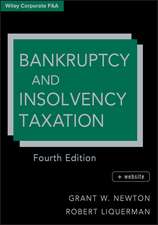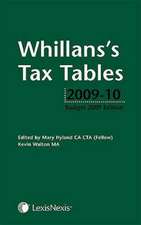Dynamic Firm and Investor Behaviour under Progressive Personal Taxation: Lecture Notes in Economics and Mathematical Systems, cartea 305
Autor Geert-Jan C. T. van Schijndelen Limba Engleză Paperback – 11 mai 1988
Din seria Lecture Notes in Economics and Mathematical Systems
-
 Preț: 360.02 lei
Preț: 360.02 lei -
 Preț: 383.93 lei
Preț: 383.93 lei -
 Preț: 384.09 lei
Preț: 384.09 lei -
 Preț: 380.07 lei
Preț: 380.07 lei -
 Preț: 446.26 lei
Preț: 446.26 lei -
 Preț: 497.37 lei
Preț: 497.37 lei -
 Preț: 380.84 lei
Preț: 380.84 lei -
 Preț: 384.86 lei
Preț: 384.86 lei -
 Preț: 378.34 lei
Preț: 378.34 lei -
 Preț: 399.67 lei
Preț: 399.67 lei - 20%
 Preț: 360.93 lei
Preț: 360.93 lei - 15%
 Preț: 643.16 lei
Preț: 643.16 lei -
 Preț: 379.09 lei
Preț: 379.09 lei -
 Preț: 404.74 lei
Preț: 404.74 lei -
 Preț: 385.62 lei
Preț: 385.62 lei - 15%
 Preț: 644.49 lei
Preț: 644.49 lei -
 Preț: 379.09 lei
Preț: 379.09 lei -
 Preț: 345.50 lei
Preț: 345.50 lei -
 Preț: 425.80 lei
Preț: 425.80 lei -
 Preț: 378.34 lei
Preț: 378.34 lei - 18%
 Preț: 775.65 lei
Preț: 775.65 lei -
 Preț: 392.60 lei
Preț: 392.60 lei -
 Preț: 401.61 lei
Preț: 401.61 lei - 15%
 Preț: 646.43 lei
Preț: 646.43 lei -
 Preț: 382.18 lei
Preț: 382.18 lei -
 Preț: 378.34 lei
Preț: 378.34 lei - 15%
 Preț: 637.59 lei
Preț: 637.59 lei - 15%
 Preț: 647.27 lei
Preț: 647.27 lei -
 Preț: 377.73 lei
Preț: 377.73 lei -
 Preț: 447.84 lei
Preț: 447.84 lei - 15%
 Preț: 644.49 lei
Preț: 644.49 lei -
 Preț: 386.00 lei
Preț: 386.00 lei - 15%
 Preț: 654.43 lei
Preț: 654.43 lei -
 Preț: 415.02 lei
Preț: 415.02 lei -
 Preț: 411.54 lei
Preț: 411.54 lei -
 Preț: 398.92 lei
Preț: 398.92 lei -
 Preț: 398.92 lei
Preț: 398.92 lei -
 Preț: 392.75 lei
Preț: 392.75 lei - 15%
 Preț: 635.47 lei
Preț: 635.47 lei - 20%
 Preț: 653.56 lei
Preț: 653.56 lei -
 Preț: 379.86 lei
Preț: 379.86 lei -
 Preț: 495.46 lei
Preț: 495.46 lei -
 Preț: 447.99 lei
Preț: 447.99 lei -
 Preț: 378.71 lei
Preț: 378.71 lei - 15%
 Preț: 637.13 lei
Preț: 637.13 lei -
 Preț: 385.84 lei
Preț: 385.84 lei -
 Preț: 378.54 lei
Preț: 378.54 lei - 15%
 Preț: 666.55 lei
Preț: 666.55 lei -
 Preț: 380.07 lei
Preț: 380.07 lei
Preț: 386.39 lei
Nou
Puncte Express: 580
Preț estimativ în valută:
73.94€ • 77.10$ • 61.45£
73.94€ • 77.10$ • 61.45£
Carte tipărită la comandă
Livrare economică 21 martie-04 aprilie
Preluare comenzi: 021 569.72.76
Specificații
ISBN-13: 9783540192305
ISBN-10: 3540192301
Pagini: 232
Ilustrații: X, 215 p.
Dimensiuni: 170 x 244 x 12 mm
Greutate: 0.38 kg
Ediția:Softcover reprint of the original 1st ed. 1988
Editura: Springer Berlin, Heidelberg
Colecția Springer
Seria Lecture Notes in Economics and Mathematical Systems
Locul publicării:Berlin, Heidelberg, Germany
ISBN-10: 3540192301
Pagini: 232
Ilustrații: X, 215 p.
Dimensiuni: 170 x 244 x 12 mm
Greutate: 0.38 kg
Ediția:Softcover reprint of the original 1st ed. 1988
Editura: Springer Berlin, Heidelberg
Colecția Springer
Seria Lecture Notes in Economics and Mathematical Systems
Locul publicării:Berlin, Heidelberg, Germany
Public țintă
ResearchCuprins
One: Scope and Outline of the Book.- 1.1. Principal aim of the book.- 1.2. Theory of corporate finance.- 1.3. Dynamics of the firm.- 1.4. Relevance and motivation of the book.- 1.5. Subproblems.- 1.6. Outline of the book.- Two: Models of Dynamic Behaviour.- 2.1. Introduction.- 2.2. Dynamic and -management modelling.- 2.3. A dynamic theory of the firm: investment, finance and dividend.- 2.4. Dynamic modeling: survey and conclusions.- Three: Taxation and some Implications.- 3.1. Introduction.- 3.2. Some examples.- 3.3. Fiscal (non) neutrality.- 3.4. Different types of profit and income tax regimes.- 3.5. Leverage and the value of a firm.- 3.6. Leverage and market equilibrium.- 3.7. Conclusion.- Four: Financial Market Equilibrium under Taxation and Tax Induced Clienteles Effects.- 4.1. Introduction.- 4.2. Dividend and leverage irrelevancy theorem under personal taxation.- 4.3. Dividend and financial leverage clienteles.- 4.4. Equilibrium market value reconsidered by Gordon.- 4.5. Discussion and extension of Gordon’s framework.- 4.6. A corrected equilibrium approach.- 4.7. Tax induced investment clienteles.- 4.8. Conclusion.- Five: Optimal Policy String of a Single Value Maximizing Firm under Personal Taxation.- 5.1. Introduction.- 5.2. The model.- 5.3. Optimal solution.- 5.4. Further analysis.- 5.5. Sensitivity analysis.- 5.6. Conclusion.- Six: Individual Investor Behaviour under Equilibrium Conditions.- 6.1. Introduction.- 6.2. Free end point approach under equilibrium conditions.- 6.3. A competitive approach.- 6.4. A differential game approach.- 6.5. Conclusion.- Seven: A Time Dependent Equilibrium Approach under a Progressive Personal Tax.- 7.1. Introduction.- 7.2. Optimal behaviour of an equity financed firm.- 7.3. Valuation of the firm’s policy string.- 7.4.Market equilibrium approach.- 7.5. Final results and conclusion.- Eight: Conclusions.- Appendix A1: The Solution of the Optimal Control Problems Formulated in the Chapters Two and Five.- Appendix A2: Derivation of a Particular Expression in Chapter Five.- Appendix B1: Derivation of Optimal Switching Point.- Appendix B2: Solution of Optimal Control Problem Formulated in Chapter Six.- Appendix B3: A Pareto Solution of a Differential Game.- Appendix C: Derivation of a Particular Expression in Chapter Seven.- List of Symbols.- References.









